Power Pitch
Novel Methods in Cerebrovascular Contrast Mechanism
ISMRM & ISMRT Annual Meeting & Exhibition • 10-15 May 2025 • Honolulu, Hawai'i

| 15:45 |
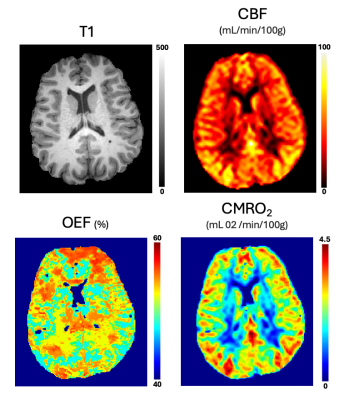 |
Screen Number: 26
0718. Estimation
of Cerebral Oxygen Extraction Fraction (OEF) by
Haematocrit-Corrected QQ (QSM + qBOLD) in Sickle Cell Anaemia
I. Hawley, M. Lee, H. Stotesbury, K. Shmueli, C. Clark, J.
Cho, F. Kirkham
Developmental Neurosciences, UCL Great Ormond St. Institute of Child Health, London, United Kingdom
Impact: QQ (QSM + qBOLD) enables a non-invasive method
of studying haemodynamic health via regional estimation of
OEF and CMRO2 in
participants, of all ages, with SCA. The differences found
suggest the important role of cerebral metabolism in tissue
injury.
|
| 15:47 |
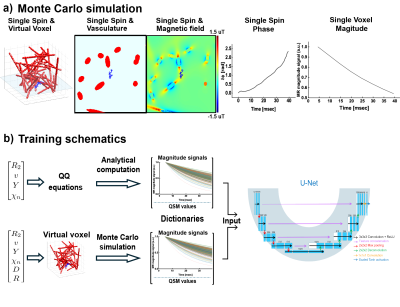 |
Screen Number: 27
0719. Enhanced
QQ-based Oxygen Extraction Fraction Mapping by Incorporating
Realistic Water Diffusion and Vasculature: QQ-MASTER

R. Yang, A. Ally, J. Cho
UB SUNY, Buffalo, United States
Impact:
The proposed QQ-MASTER enables accurate OEF quantification for both healthy tissue and abnormal stroke lesion by considering comprehensive and realistic physiological scenarios. QQ-MASTER is therefore clinically applicable in various neurologic disorders, aiding in assessing disease severity and developing therapeutic targets. |
| 15:49 |
 |
Screen Number: 28
0720. Estimating
blood oxygen saturation through susceptibility sources
separation: a new standpoint on quantitative BOLD models

L. Chalet, S. Rigollet, V. Stupar, A. Delphin, T.
Coudert, B. Lemasson, E. Barbier, L. Mechtouff, T.
Boutelier, E. Canet-Soulas, T. Christen
Univ. Claude Bernard Lyon1, Lyon, France
Impact: Unraveling extravascular and intravascular
signal contributions using our new model holds promise for
the characterization of tissular magnetic properties and
oxygenation which may serve as biomarkers of hypoxia and
predictive tools of damage reversibility in clinical
ischemic stroke.
|
| 15:51 |
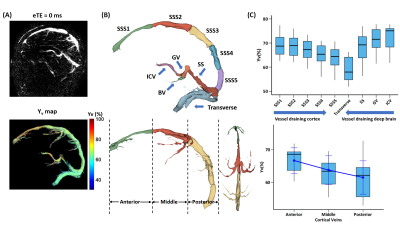 |
Screen Number: 29
0721. Accelerated
3D mapping of whole brain venous oxygenation with nested-shift
under sampling and ESPIRIT reconstruction
Y. Hong, D. jiang, Y. Zhang, Y-C Hsu, H. Lu, D. Wu, Z. Lin
Zhejiang University, HangZhou, China
Impact: The 3D TRU-VERA sequence enables rapid,
non-invasive assessment of venous oxygenation (Yv)
across the entire brain, providing vessel-specific
quantification and comprehensive evaluation of regional
cerebral oxygen metabolism.
|
| 15:53 |
 |
Screen Number: 30
0722. A
Gradient Echo-Spin Echo BOLD framework for quantitative mapping
of OEF and CMRO2 with calibrated functional MRI
A. Chiarelli, S. Pomante, F. Fasano, M. E. Caligiuri, S.
Censi, D. Di Censo, E. Bliakharskaia, M. Carriero, F.
Graziano, A. Caporale, E. Biondetti, R. Wise, M. Germuska
University G. D'Annunzio of Chieti-Pescara, Chieti, Italy
Impact: The GE/SE BOLD calibrated fMRI framework appears
feasible. It may allow for robust inference of OEF and CMRO2 maps
through a single vasodilatory stimulus and without the need
for functional ASL recordings.
|
| 15:55 |
 |
Screen Number: 31
0723. Rapid
measurement of cerebral venous oxygenation using EPI-based
T2-Relaxation-Under-Phase-Contrast (TRUPC)

Y. Gou, W. Shi, J. Song, H. Lu
Johns Hopkins University School of Medicine, Baltimore, United States
Impact: We developed a MR technique for accurate and
reliable Yv measurement on brain veins within 1.5 minutes.
It showed nice reproducibility and consistency under
different challenges with previously developed sequence.
|
| 15:57 |
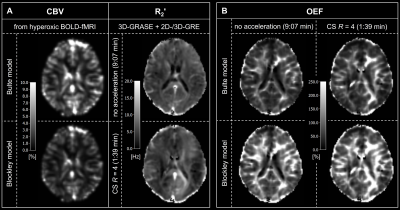 |
Screen Number: 32
0724. Fast
and Non-Invasive Oxygen Extraction Fraction Mapping Using
Hyperoxic BOLD-fMRI and Deep-Learning-Accelerated Relaxometry
E. Saks, S. Kaczmarz, N. Blockley, C. Zimmer, C. Preibisch,
G. Hoffmann
Institute for Neuroradiology, School of Medicine and Health, TUM University Hospital, Technical University of Munich, Munich, Germany
Impact: We investigated CBV estimation from hyperoxic
BOLD-fMRI with two quantification models as a non-invasive
alternative to contrast-agent-based DSC MRI, and the
reduction of R2ʹ acquisition
time by DL-based acceleration. Ultimately, this parameter
combination enables fast and non-invasive OEF mapping.
|
| 15:59 |
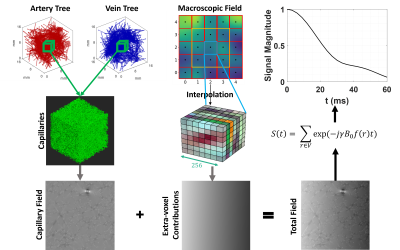 |
Screen Number: 33
0725. SynthOEF:
Oxygen Extraction Fraction (OEF) Mapping from multi
Gradient-Echo Data using a U-Net trained with Synthetically
Generated Data
M. Sisman, H. Zhuang, A. Roberts, L. Zhou, S. Zhang, Y. Li,
M. de Leon, G. Chiang, T. Nguyen, P. Spincemaille, Y. Wang
Cornell University, Ithaca, United States
Impact: Oxygen Extraction Fraction (OEF) is an important
clinical biomarker of tissue viability. Noninvasive
measurement of OEF might have high clinical impact by
providing critical knowledge of tissue health in diseases
such as stroke, Alzheimer’s disease, and multiple sclerosis
(MS).
|
| 16:01 |
 |
Screen Number: 34
0726. Alteration
of Water Exchange Rates Following Focused ultrasound-Mediated
BBB Opening in the Dorsal Striatum: A Diffusion-Prepared pCASL
Study
D. Liu, X. Shao, S. Sanatkhani, F. Munoz, E. Konofagou, D.
Wang, V. Ferrera
Columbia University, New York, United States
Impact: This study evaluated a non-contrast MRI method
to assess focused ultrasound-induced BBB opening, providing
a safer alternative to gadolinium-based agents for
monitoring BBB permeability changes and supporting clinical
advances in FUS-mediated drug delivery and neuromodulation.
|
| 16:03 |
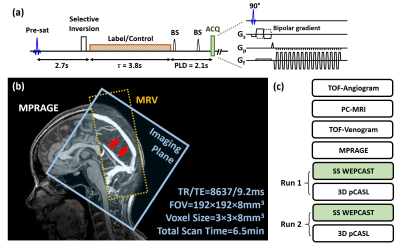 |
Screen Number: 35
0727. Noncontrast
assessment of blood-brain barrier permeability to water:
improved reliability and spatial specificity

W. Shi, J. Song, J. Wu, Y. Gou, Z. Hu, D. Jiang, Z. Lin,
H. Lu
Johns Hopkins University School of Medicine, Baltimore, United States
Impact: Non-contrast WEPCAST MRI based on the
generalized venous signal model can reliably measure
blood-brain-barrier permeability to water with spatial
specificity, which has great potential in studying
neurological diseases and relevant clinical applications.
|
| 16:05 |
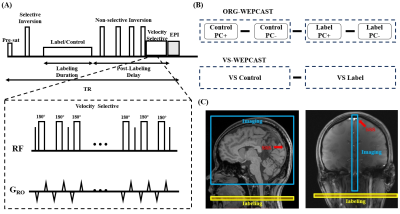 |
Screen Number: 36
0728. Non-contrast
measurement of BBB permeability using an accelerated WEPCAST MRI
with velocity-selective single-shot acquisition
Y. Hu, y-c Hsu, D. Wu, H. Lu, L. Zhao, Z. Lin
Zhejiang University, Hangzhou, China
Impact: This study proposed an accelerated
velocity-selective WEPCAST technique that enables the
assessment of global BBB permeability to water in nearly
half the original scan time, with improved robustness to
motion and cardiac pulsation.
|
| 16:07 |
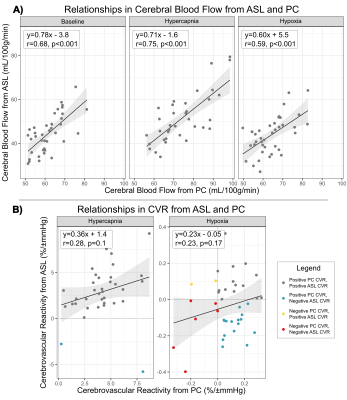 |
Screen Number: 37
0729. Cerebrovascular
Reactivity Under Hypercapnia and Hypoxia: Comparing Whole-Brain
and Regional Measurements from Phase-Contrast and ASL MRI
H. Johnson, M. Bright
Northwestern University, Chicago, United States
Impact: We show that ASL measures of cerebrovascular
reactivity are significantly lower than phase-contrast
measures, and atypical CVR values found in ASL may result
from changes in labeling efficiency. Hypoxic CVR variability
does not seem to be driven by regional differences.
|
| 16:09 |
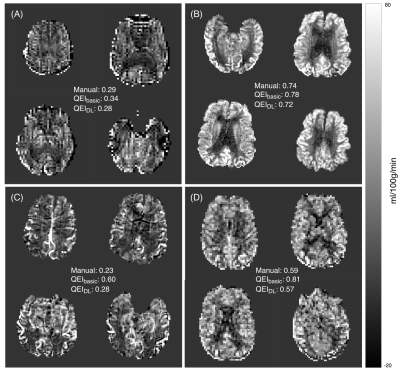 |
Screen Number: 38
0730. QEI-Net:
A Deep learning-based automated quality evaluation index for ASL
CBF Maps

X. Beltran Urbano, M. Taso, I. Nasrallah, J. Detre, Z.
Wang, S. Dolui
University of Pennsylvania, Philadelphia, United States
Impact: We propose QEI-Net, a deep learning based
automated quality evaluation method for Arterial Spin
Labeling (ASL) derived cerebral blood flow images. QEI-Net
can enable consistent and reproducible quality assessments
and reduce the time burden and subjectivity in studies using
ASL.
|
| 16:11 |
 |
Screen Number: 39
0731. Whole-cerebrum
Arterial Spin Labeling Perfusion at 7T with isotropic 1 mm and
sub-millimeter resolution with 3D TFL-pCASL and Stack-of-Spirals
C. Zhao, Z. Yang, F. Guo, Q. Shou, X. Shao, A. Beckett, E.
Walker, S. Ma, D. Feinberg, D. Wang
University of Southern California, Los Angeles, United States
Impact: This study presents high-resolution ASL
perfusion imaging at 7T, providing fine-grained assessments
of brain structure and function with comparable resolutions
and details of structural MRI.
|
| 16:13 |
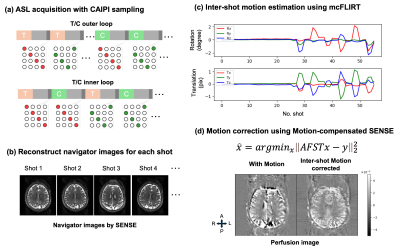 |
Screen Number: 40
0732. Motion-Robust
ASL Perfusion Imaging with Self-Navigation Using 3D GRASE and
CAIPI Sampling
M. Hu, M. Chiew, F. Lange, P. Jezzard, J. Woods, T. Okell
University of Oxford, Oxford, United Kingdom
Impact: We investigate a motion-robust pCASL sequence
using a segmented 3D GRASE readout with CAIPI sampling,
improving perfusion image quality in the presence of
inter-shot motion without increasing scan time. This
approach facilitates future clinical applicationwith less
cooperative patients.
|
| 16:15 |
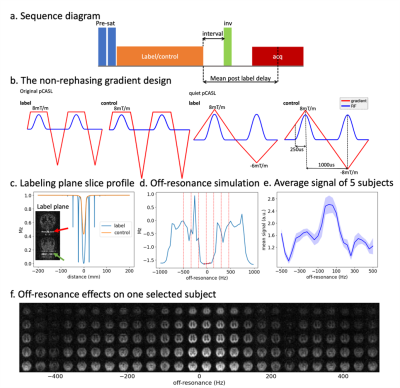 |
Screen Number: 41
0733. Quiet
ASL with Non-rephasing Labeling Gradients and Silent Readout

E. Zheng, J. Zhang, J. Li, L. Zhao
Zhejiang University, Hangzhou, China
Impact: The proposed quiet ASL provided a novel approach
to label blood. It may improve patients experience and have
a great potential in resting state fMRI studies.
|
| 16:17 |
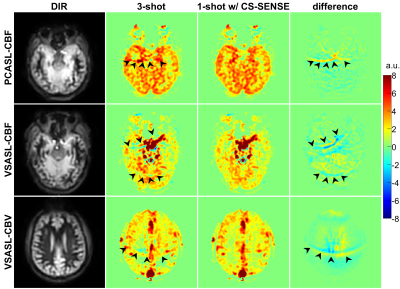 |
Screen Number: 42
0734. A
straightforward approach for 3D single-shot ASL based brain
perfusion imaging: preventing artifacts due to signal
fluctuations
D. Zhu, F. Xu, D. Liu, Q. Qin
Kennedy Krieger Institute, Baltimore, United States
Impact: This study showed that inter-shot signal
fluctuations could cause artifacts for multi-shot arterial
spin labeling, which were prevented using single-shot.
Single-shot is recommended for all scans with potentially
large signal fluctuations, which could be achieved with
stack-of-spirals turbo FLASH acquisition.
|
| 16:19 |
 |
Screen Number: 43
0735. MOdulation-Guided
ENcoding (MOGEN) Scheme for Vessel-Encoded Arterial Spin
Labeling Planning

H. Li, T. Okell, J. Woods, Y. Ji, Y. Suzuki, Z. Sun, Y-H
Chu, Y-C Hsu, H. Wang, Z. Chen
Fudan University, Shanghai, China
Impact: Our study proposed a novel VEASL encoding
method, MOGEN, guided by modulation information which is
better suited to various PCASL parameter setting, further
enhancing the SNR.
|
| 16:21 |
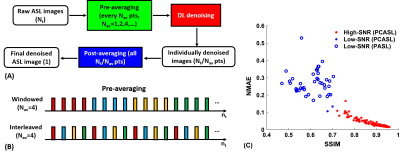 |
Screen Number: 44
0736. Optimizing
arterial spin labeling denoising with deep learning – effects of
averaging and training strategies
J. Guo, A. Sharma, H. Rahimzadeh
University of California, Riverside, Riverside, United States
Impact: This is the first study to systematically
investigate the effects of different averaging and training
strategies in DL-based ASL denoising. The results will help
guide ASL scan and post-processing designs for significant
reduction of scan time while achieving optimal performance.
|
| 16:23 |
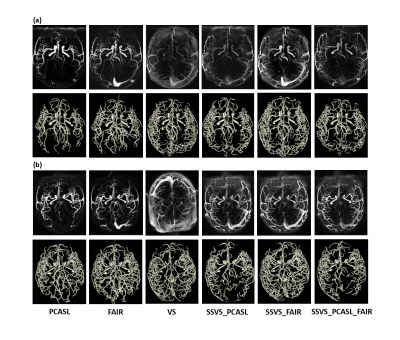 |
Screen Number: 45
0737. Multi-module
ASL MRA sequences for improving visualization of distal small
brain vessels

Z. Sun, H. Li, L. Liu, Y. Liao, J. Wang, T. Qian, L.
Wang, Y. Chu, H. Wang, Z. Chen
Fudan University, Shanghai, China
Impact: The results indicate that combining SSVS and
FAIR can improve imaging of distal small brain vessels, with
little compromise for imaging of the proximal vessels,
therefore has a great clinical potential.
|
| 16:25 |
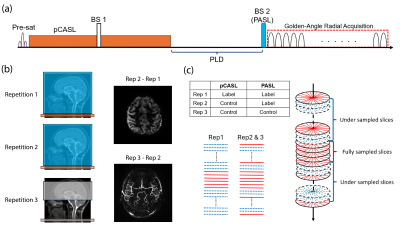 |
Screen Number: 46
0738. Simultaneous
intracranial 4D MRA and perfusion imaging using dual-ASL modules
with 3D stack-of-stars golden-angle radial acquisition
T. Zhao, Z. Li, L. Yan
Northwestern University, Chicago, United States
Impact: The developed dual-ASL technique could be a
potentially powerful imaging tool in clinical applications,
which provides a detailed characterization of flow
hemodynamics from both arterial and capillary beds by a
single scan.
|
| 16:27 |
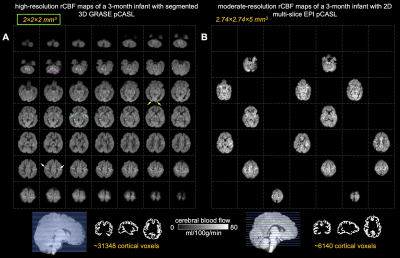 |
Screen Number: 47
0739. High-fidelity
infant regional cerebral blood flow map with isotropic 2mm
resolution acquired through segmented 3D GRASE pCASL
M. Ouyang, M. Vidorreta, M. Taso, J. Detre, H. Huang
Children's Hospital of Philadelphia, Philadelphia, United States
Impact: Capitalizing on an advanced segmented 3D GRASE
pCASL with background suppression, we acquired the
highest-resolution infant CBF maps available at isotropic
2mm, providing unprecedented details of regional CBF
variations across whole infant brain structures
characterized by small sizes.
|
| 16:29 |
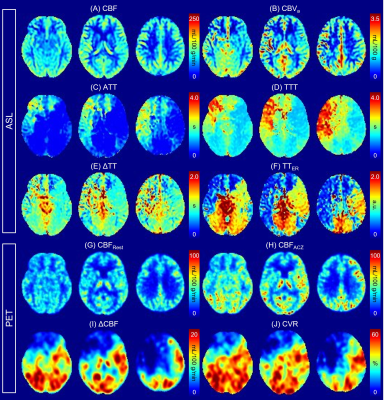 |
Screen Number: 48
0740. Comparison
between multiparametric arterial spin labeling and 15O-water
positron emission tomography in patients with moyamoya disease
S. Ishida, H. Kimura, M. Isozaki, K. Takata, Y. Matta, T.
Tsujikawa, H. Okazawa
Kyoto College of Medical Science, Kyoto, Japan
Impact: Multiparametric arterial spin labeling enables a
detailed, noninvasive evaluation of cerebral hemodynamics in
patients with moyamoya disease, with a clinically acceptable
scan time, and potentially allows for the detection of
early-stage hemodynamic impairment in these patients.
|
| 16:31 |
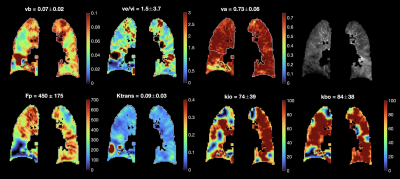 |
Screen Number: 49
0741. Modeling
contrast agent dynamics in the lung: effects of tissue volume
fractions and intercompartmental water exchange in pulmonary
DCE-MRI

J. Marchant, P. Caravan, B. Rosen, I. Zhou
Athinoula A. Martinos Center for Biomedical Imaging, Department of Radiology, Massachusetts General Hospital and Harvard Medical School, Charlestown, United States
Impact: The proposed model provides an analytical tool
for absolute quantification of pulmonary perfusion and
microvascular parameters in the lung and could enable
improved patient care and treatment development in the
setting of fibrotic lung disease.
|
| 16:33 |
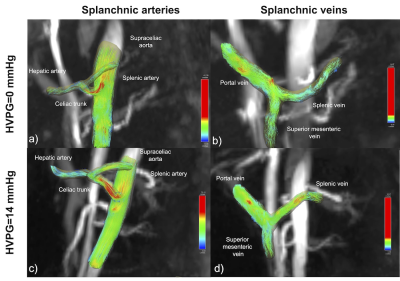 |
Screen Number: 50
0742. 4D
flow MRI of splanchnic vasculature for diagnosis of severe
portal hypertension and prediction of outcomes
O. Bane, A. Geahchan, D. Stocker, G. Abboud, P. Kennedy, H.
Sharma, S. Hectors, S. Thung, N. Jin, A. Fischman, M. Markl,
S. Reeder, T. Schiano, B. Taouli
Icahn School of Medicine at Mount Sinai, New York, United States
Impact: 4D flow MRI diagnoses severe portal hypertension
with excellent performance, and predicts hepatic
decompensation with equivalent performance to HVPG, making
it suitable for integration into surveillance MRI protocols
for patients with liver cirrhosis.
|
The International Society for Magnetic Resonance in Medicine is accredited by the Accreditation Council for Continuing Medical Education to provide continuing medical education for physicians.